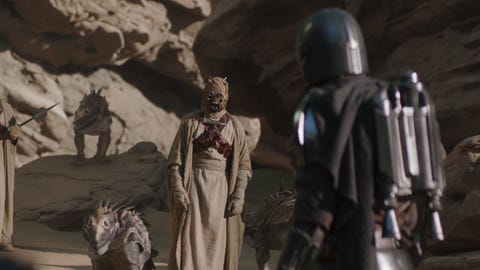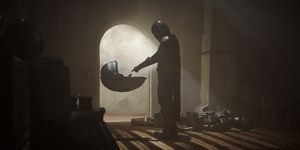Spoilers for The Mandalorian season 2 episode 1, “Chapter 9: The Marshal,” below.
This year was meant to see the arrival of Denis Villeneuve’s Dune adaptation, but never fear: The
Lucas never actually credited Herbert for the obvious inspiration, but the author was aware. He’s said to have claimed at least 37 similarities between the Star Wars franchise and his book about an intergalactic war with an evil emperor, a desert planet with nomadic people, beastly sandworms, a mystical order with powers, and a messianic young boy with a destiny to fulfill. Herbert even said of the original film’s 1979 release, “I'm going to try very hard not to sue.” He succeeded, which meant Lucas got away with his interpretation and the world of Star Wars expanded into a full universe.
The Mandalorian creator Jon Favreau, however, has done a far better job of paying homage to Dune in this season 2 opener than any of the live-action Star Wars outings so far, and subverts the negative portrayal of an infamous race in the process.
“The Marshal” opens with Mando (Pedro Pascal) and The Child, aka Baby Yoda, arriving at a seedy venue in what looks like an urban slum within a cyberpunk movie. They’re there to meet Abyssin gangster Gor Koresh (John Leguizamo), who bears more than a passing resemblance to Javier Bardem’s Bond villain Raoul Silva. Mando is after information regarding the whereabouts of other Mandalorians after Moff Gideon (Giancarlo Esposito) decimated his collective, The Tribe, at the end of season 1. Gor learns the hard way not to mess with our hero, and after taking out the criminal’s crew with some stunning hand-to-hand combat soundtracked by an ‘80s guitar riff, Mando and The Child head back to Tatooine to seek out a mysterious Mandalorian residing in the mining settlement of Mos Pelgo.
Landing on the desert planet, the pair are reunited with mechanic Peli Motto (Amy Sedaris), and we are all Peli when she squeals in excitement at seeing Baby Yoda again. She and her droids get to work fixing up Mando’s ship while the two borrow a speeder to locate Mos Pelgo. Upon arrival, viewers are greeted with the first blast from the past: The town’s Marshal wearing Boba Fett’s armor. It was assumed Fett had perished in Return of the Jedi after falling into the deadly pit of Sarlacc, but the final moments of this episode prove that was not the case (more on that later). Fett’s armor ended up in the possession of the Jawa, a scavenger people, and they sold it to the Marshal, a human named Cobb Vanth.

Timothy Olyphant couldn’t be more suited for the space western world of The Mandalorian, delivering exactly the right amount of rugged swagger one would expect from the star of Justified and Deadwood. Cobb became the town’s protector after the Empire fell and the local Mining Collective turned Mos Pelgo into a slave camp. In Fett’s armor, Cobb takes out the new oppressors and maintains order thanks to the deadly reputation of the warrior race who wears it.
But only Mandalorians are meant to wear their Beskar armor, so Mando is obliged to take it from Cobb. However, when a Krayt dragon turns up and eats one of the town’s Bantha, a hairy mammoth-looking mammal, the two forget a stand-off and strike up a bargain instead: Cobb will return the armor if Mando helps kill the Krayt. Fans will remember that Obi-Wan Kenobi used the call of a Krayt dragon to scare off the Tusken Raiders in A New Hope, so it is rather fitting that Favreau brought back the Sand People for this episode, and pretty amazing that he ameliorates the negative characterization Lucas gave them.
The Star Wars creator famously used Tunisia as a backdrop for Tatooine (the set remains there to this day) and claims he based the Tuskens on the Bedouins, a nomadic Arab people who lived in the region—much like the Berbers who served as an influence on the depiction of the Fremen in Dune. The similarities between the Tusken Raiders and the desert-dwelling people of Arrakis in Herbert’s novel are pretty clear: They both wear head-to-toe clothing to survive the harsh desert climate and are resistant to outside colonizers taking the planet’s natural resources (water in Star Wars; water and spice in Dune). They have a strong sense of community and shared mystical beliefs, are knowledgeable about the colossal worm-like beasts (Krayt dragons in Star Wars/sandworms in Dune) that inhabit the dunes, and are brutal in combat.

But while Herbert is somewhat empathetic in his portrayal of the Fremen and their struggle—Dune dismantles the very idea of saviors, heroes, and villains that Star Wars props up—Lucas’s series painted his Sand People as merely xenophobic savages. Their language is made up of grunts and growls and their cinematic appearances are defined by ferocious hostility. Tuskens knock Luke unconscious to steal from him in A New Hope, and in the prequel series, a group kidnaps and tortures Anakin’s mother, doubling down on the perception that they are soulless killers and giving Anakin an excuse to turn to the Dark Side. The Sand People were certainly not a welcome appropriation of Arab and North African culture to those of that heritage, and though in other Star Wars media they’ve been given more backstory and nuance, it’s a welcome sight to see Favreau’s humanization of them in live-action form.
It started in The Mandalorian season 1, during the episode “The Gunslinger.” The scene depicts the Tusken Raiders as reasonable when Mando barters for safe passage; he uses their dialect and sign language and gives them binoculars as payment. In “The Marshal,” Mando, Cobb, and Baby Yoda encounter a group and again, our hero communicates using their language and convinces them to join the fight against the Krayt dragon. Cobb doesn’t trust them because they attacked his village, but their hostility wasn’t because they are senselessly brutal—rather, they were defending the water they believed the miners were stealing. Mando’s defense of the Tusken Raiders is important because it contextualizes their ways of life. “They are brutal and so is the dune sea,” he says. “They are raiders, this is true, but they also keep their word.”
The mention of “dune” here seems like a knowing nod to the novel, as does the episode’s sandworm storyline depicting people of different backgrounds teaming up for a cause. By portraying the Tusken Raiders as more enlightened beings than the savages of Lucas’s films, Favreau shows a better understanding of what Herbert was trying to do with the Fremen, and a respect for the nomadic North African people upon which both Dune and Star Wars' fictional races are based.
By the episode’s end, the Raiders, Mando, Cobb, and the villagers form an alliance to destroy the Krayt and a peace treaty is made between the former rivals. And as Mando heads off with The Child and Fett’s armor, the legend who used to wear it looks down on the scene ominously before walking off into the distance. Where he's going is yet to be determined, but it sure is good to see Temuera Morrison’s Jango Fett again. Until next week…
Watch The Mandalorian on Disney+




